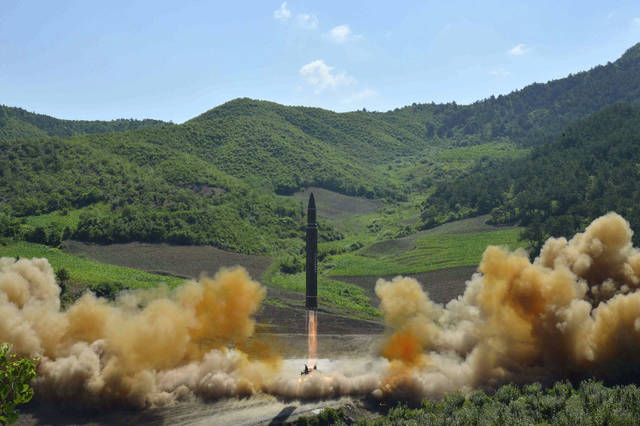State to roll out plan on how to deal with North Korean nuke

ASSOCIATED PRESS
This July 4 file photo, distributed by the North Korean government shows what was said to be the launch of a Hwasong-14 intercontinental ballistic missile in North Korea’s northwest. The state of Hawaii is rolling out a preparedness plan in the unlikely event that North Korea launches an ICBM at the Aloha State.
The state of Hawaii is rolling out a preparedness plan in the unlikely event that North Korea launches an intercontinental ballistic missile at the Aloha State.
The public education and information campaign will emphasize steps to be taken on short notice, according to state officials, because a North Korean ICBM would arrive in just 20 minutes, leaving just 12 to 15 minutes to warn the populace.
“We do not want to cause any undue stress for the public; however, we have a responsibility to plan for all hazards. We don’t know the exact capabilities or intentions of the North Korean government, but there is clear evidence that it is trying to develop ballistic missiles that could conceivably one day reach our state. Therefore, we cannot wait to begin our public information campaign to ensure that Hawaii residents will know what to do if such an event occurs,” Vern Miyagi, Hawaii Emergency Management Agency administrator, said in a release.
The plan doesn’t mean a return to “duck and cover” from the 1950s, but it will include school students drilling for evacuation, similar to “active shooter” scenarios now, officials said.
Public service announcements will be aired that advise “get inside, stay inside, and stay tuned,” according to the state.
The tourism industry is not at all happy with the arrival of the campaign, which it fears could spook tourists.
Don't miss out on what's happening!
Stay in touch with breaking news, as it happens, conveniently in your email inbox. It's FREE!
“Everyone’s safety in Hawaii is always our top priority. We support the efforts of the Hawaii Emergency Management Agency to prepare for any threat to Hawaii’s well-being, be it man-made or a natural disaster,” Charlene Chan, director of communications for the Hawaii Tourism Authority, said in a statement.
“However, we also know from speaking to our tourism industry partners that if reports are misinterpreted about the state’s need to prepare for an attack, this could lead to travelers and groups staying away from Hawaii,” she said. “The effect of such a downturn would ultimately be felt by residents who rely on tourism’s success for their livelihood.”
Chan added that the threat of a North Korean missile attack on Hawaii “is a very remote possibility at this time.”
But state officials say they want to get out ahead of North Korea’s goose-stepping march toward greater nuclear capability — even if it would be suicide for leader Kim Jong Un to launch missiles at the United States.
Miyagi and Emergency Management Executive Officer Toby Clairmont are expected to unveil more details of the preparedness plan Friday.
North Korea’s first and only successful flight test July 3 of an ICBM has some experts asserting that Hawaii now is in range of the missile known as the Hwasong-14.
Missile expert John Schilling wrote on the website 38North.org on July 10 that “the dust seems to be clearing and the emerging reality is that the North has an unreliable missile that can reach Alaska or Hawaii with a single nuclear warhead, and would be lucky to hit even a city-sized target.”
With the collapse of the Soviet Union, ICBMs came off Hawaii Emergency Management’s threat list of mostly natural hazards in the late 1990s. Terrorism was added.
With North Korea emerging as a new threat, Miyagi told the Honolulu Star-Advertiser in April that it was time to update previous plans.
“If you were to ask me what is the status of North Korea, and is (a missile attack) a high probability, no, it’s a low probability,” Miyagi, a retired Army two-star general who served at U.S. Pacific Command as a senior adviser, said at the time. “But then, so, we have to keep a lookout for that (threat). That’s why we’re talking about updating the plan. It’s an awakening,” he added.
Miyagi at the time said North Korea could be developing a 10-kiloton warhead capability. For comparison, the bomb dropped on Hiroshima in 1945 was 15 kilotons.
Hawaii Emergency Management is an all-hazards agency, “so the point is, whether it’s nuclear events, whether it’s hurricane or tsunami, the same thing that we need to get out to the folks is that they need to have a plan,” he said.
That includes coordinating with family members on meeting spots and communication when and if usual methods are disrupted.
“Know where to go, know what to do, and know when to do it,” Miyagi said.





